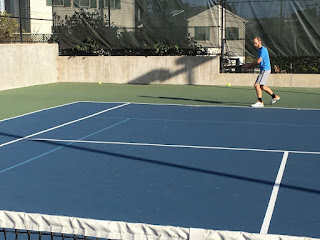I
am a member of San Francisco league.
How long have you participated in your league?
I
started in 2012 and just recently played my 112th match (as of Feb. 17th, 2017)!
How did you first learn about it?
I
moved to the Bay Area and decided to take advantage of the all-year great
weather and get back to tennis. I haven't really played in 10 years, so at
first I started hitting at my local park. As soon as I started feeling
comfortable, my competitive nature prevailed and I looked out for a league.
TennisSF caught my eye because of the flexible schedule.
How often do you play?
My
goal is to play twice a week as long as the weather permits and I am not traveling. As much as I love to travel, not being able to play tennis is one
of the few downsides.
What do you like most about the league?
I
love playing against different styles and meeting new people. Long time
rivalries are even better because you really get to know the other person and
eventually make friends. I have made several breaks from the league, but always
came back due to my competitive nature.
Tell us about your most memorable match(es)
One
of my most memorable matches was in the semi final of the playoffs in 2013,
against an opponent who beat me pretty easily in the regular season. I managed
to win in 3 close sets and it was my first win against a truly 4.0+ player! I
was really glad I could see my game improving and I remained unbeaten in 3 set
matches. I went on to win my first 4.0 championship and the semi final win
against a really good player was a milestone and a confidence booster.
Do you have any other interesting comments about your experiences
with the league?
Playing
on different courts is a great way of exploring the Bay Area! I think it is a
perfect option for people who just move to the area and don't have tennis
partners. But once you start, you're hooked up!
How did you get started playing tennis?
I
started playing when I was 12 and played until I was 16. Then I had some
injuries and focused on my education, and somehow haven't played for almost 10
years. I was shocked when I realized it's been almost 10 years and I decided to
get back to tennis, because I remembered I really liked it as a teenager.
TennisSF was a great way for me to get back to playing regularly.
What level player are you? (NTRP rating)
I
am 4.0.
What do you love about tennis?
I
love the 1 on 1 combat aspect of it. You are by yourself and you have to figure
out a way to win or at least do your best.
Who are your favorite pro players? Why?
My
favorite player is Rafa Nadal. I admire his ability to adjust his game during
the match, his competitive spirit and passion. I've tried to imitate his style
on the court.
Tell us a little bit about yourself, for example: What do
you do? Where did you grow up? What are your hobbies (besides tennis)? (Feel
free to share any interesting details about your life.)
I
grew up in Poland where soccer is by far the most popular sport. I loved
playing it as a kid. One of my friends at elementary school used to train
tennis and it was very impressive to me that he was the only person I knew who
played tennis. A few years later I decided to sign up to a club. From the get
go, I realized I was really good at it, as I was catching up much faster than
my peers. I started watching tennis on TV and Agassi-Sampras rivalry got me
really hooked. In Poland I played on clay or indoor carpet, so hard courts were
new to me after I moved to the Bay Area. I guess I still have to master grass
to become an all-court player!











